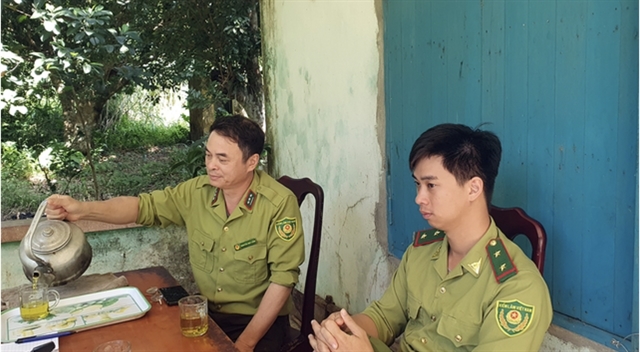Protecting the forest means safeguarding the livelihood of future generations and preserving valuable genetic resources.

Lê Ngọc Nghị, head of Cát Dứa Ranger Station under Cát Bà National Park, in a patrol in Cát Bà National Park. Photo nguoiduatin.vn
HẢI PHÒNG – The forest rangers of Cát Bà National Park in Hải Phòng City have not only dedicated their youth to protecting the forest, but they have also passed on their love for it to the next generation.
Lê Ngọc Nghị, head of Cát Dứa Ranger Station under Cát Bà National Park, is one of the rangers who has been attached to the forest for more than 40 years.
"In 1983, I started working as a labourer at Cát Bà Forest Station. In 1986, when Cát Bà National Park was established, I became a ranger here and have been ever since. My greatest joy is contributing in a small way to protecting the forest," Nghị recalled.
Nghị is one of the first rangers of the Cát Bà National Park.
Over nearly 40 years, many have retired, some lost their working ability, leaving only him and one other colleague who still remain to protect the forest.
According to the forest ranger, when the park was first established, the biggest challenge was transitioning from forest exploitation to forest protection.
“For the rangers, the job became even more challenging due to conflicts with many local people who had long relied on the forest for wood, medicinal plants, and hunting,” Nghị told nguoiduatin.vn.
“Between 1986 and 1990, conflicts escalated as local people dependent on the forest resented the rangers of Cát Bà National Park for restricting their access to their livelihood,” he said.
Since 1990, the tensions have gradually eased and stopped.
Nowadays, the rangers are greeted warmly by people in many areas such as Việt Hải, Gia Luận, Hiền Hào, Xuân Đám, and Trân Châu in Cát Hải District.
Explaining this change, Nghị said that through active outreach and persuasion, people have come to understand and sympathise with the rangers' work.
In particular, as tourism has developed, many locals have shifted to tourism-related jobs, which offer higher and more stable incomes, helping them leave behind the difficult and dangerous life of forest work.
"Having dedicated my youth to protecting the forest and soon retirement, I only hope that younger rangers will continue this work,” Nghị said.
“Protecting the forest means safeguarding the livelihood of future generations and preserving valuable genetic resources," he said.
Silent "langur guardians"

Father and son Nguyễn Huy Cầm and Nguyễn Huy Thành. Photo nguoiduatin.vn
Among those who love the Cát Bà langur — the world’s second most endangered primate, found only in Cát Bà National Park — everyone knows Nguyễn Huy Cầm, deputy head of Eo Bùa Ranger Station under Cát Bà National Park.
Cầm has been dedicated to the Cát Bà langur for nearly 20 years and captured numerous invaluable images and footage of them.
Cầm said that he began working as a ranger at Cát Bà National Park in 1994.
When the park established a langur sanctuary in Giỏ Cùng, he was assigned there.
Later, he became the park’s "special envoy" to collaborate with and assist a non-governmental organisation in the Cát Bà Langur Conservation Project.
Recently, due to his parents’ serious illnesses, Cầm requested to be transferred to Eo Bùa Ranger Station to be closer to them.
"Throughout my time with the Cát Bà langur, two incidents have left a lasting sadness. The first was in the winter of 2019. While patrolling by sea, I saw a male langur attacking another group. It bit a newborn langur, throwing it into the sea. Despite the cold, I jumped into the water to save the baby langur and brought it to the Cát Bà National Park centre.”
“The baby langur was then sent to the rescue centre at Cúc Phương National Park for treatment. Unfortunately, it died en route due to severe injuries,” he recalled.
The second incident occurred some time later, when he witnessed a male langur kill five newborns.
“After observing closely, I saw one infant’s body floating on the water, still barely alive. I took it back to the park centre, but it too did not survive," Cầm said with eyes moist with tears.
Cầm’s love for the forest and the Cát Bà langur has been passed on to his son, Nguyễn Huy Thành, born in 1998.
Thành officially became a ranger at Cát Bà National Park in October 2024.
"Since I was young, I went to the forest with my father whenever possible. I grew to love the forest through his stories and those of other rangers, especially the images of the langur herds that he captured and cherished,” Thành said.
“So, even though I had opportunities to work in companies with incomes three to four times higher, I chose to follow in my father's footsteps as a ranger to protect the forest and the Cát Bà langur," the newly-employed ranger said.

Langurs in Cát Bà National Park. Photo nguoiduatin.vn
According to Phạm Văn Phúc, deputy director of Cát Bà National Park, since the beginning of the year, 15 new langur babies have been born, bringing the total population to over ninety individuals — the highest count in decades.
Recently, golden monkeys have been spotted descending to the park centre to play. At night, the calls of geckos fill the air, and occasionally, people catch sight of large Burmese pythons gliding along the roadside.
Not only the Cát Bà langur, but other wildlife in Cát Bà National Park is also "reviving" thanks to protection efforts. VNS